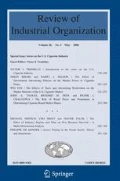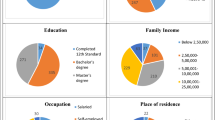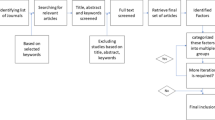Abstract
Recent legislation and court settlements in the United States allow merchants to use price discounts to steer customers to pay with means of payment that are less costly to merchants. We use transaction data to compute rough estimates of the expected net cost reduction by merchant type of giving debit card and cash price discounts. We find that steering consumers to debit and cash via simple price discounts reduces most merchants’ card processing cost; however, this reduction is small and may be insufficient to offset the increase in the cost of administering price menus that vary by payment instrument.



Similar content being viewed by others
Notes
See Barron et al. (1992) for the history of cash discounts in the U.S. following the 1981 Cash Discount Act (H.R. 31), which became Public Law No: 97–25; see http://thomas.loc.gov/cgi-bin/bdquery/z?d097:H.R.31:.
See Final Judgment as to Defendants MasterCard International Inc. and Visa Inc., Civil Action No. CV-10-4496 (E.D.N.Y. Oct. 4, 2010), which is available at http://www.justice.gov/atr/cases/f262800/262875.htm. American Express was not part of this settlement; therefore, merchants who accept all cards may still have to adhere to the pre-settlement American Express anti-steering rules.
Rochet and Tirole (2008) analyze the impact of the “honor-all-cards” rule, in which card networks “force” merchants to accept a network’s credit card whenever the merchants accept a debit card that bears the same network logo (such as Visa and MasterCard). They focus on how the card networks adjust the relative cost that is imposed on merchants and card users via the use of interchange fees. The “honor-all-cards” rule has been abandoned in the United States and some other countries. Gill and Thanassoulis (2013) show that providing a discount to price sensitive consumers weakens competition because merchants have lower incentives to undercut the listed prices of their competitors.
These observations have been confirmed by various cost studies. In Garcia-Swartz et al. (2006) Table 2-1 reports that the per-transaction processing costs were $0.27 for cash, $1.14 for credit card, $0.75 for signature debit, and $0.57 for PIN debit. Of these total costs, the bank charges component was $0.004 for cash, $0.94 for credit card, $0.56 for signature debit, and $0.41 for PIN debit.
Under the currently regulated debit card fees given in Eq. (2), some low-value debit card transactions may be more costly to merchants than credit card transactions.
As pointed out by the editor, there is no particular reason why we model \(s\) as insensitive to the consumer discount rate, \(d\). Similar simulations could use different configurations where \(s=f(d)\). In this case, \(f'(d)>0\) (\(f'(d)<0\)) implies that the fraction of buyers who change their payment instrument is increasing (decreasing) with the discount rate.
See http://www.federalreserve.gov/newsevents/press/bcreg/20110629a.htm and 12 CFR Part 235, Debit Card Interchange Fees and Routing; Final Rule, Federal Register Volume 76, Number 139 (Wednesday, July 20, 2011), available at http://www.gpo.gov/fdsys/pkg/FR-2011-07-20/html/2011-16861.htm. The final rule allows a fraud prevention adjustment of 1 cent to be added to the 21 per transaction interchange fee, thereby effectively making the maximum fixed part of the fee equal to 22 cents per transaction. On July 27, 2012, the Federal Reserve Board made the 1 cent adjustment to the interchange fee permanent, see http://www.federalreserve.gov/newsevents/press/bcreg/20120727a.htm. On July 31, 2013, in a legal decision in a lawsuit against the Federal Reserve that was brought by merchants that sought yet lower fees, a Federal Judge rejected the Fed’s cap on debit card fees; this ruling has been appealed, but an appellate decision has not been reached.
Because this fee schedule constitutes the maximum permissible fee, a question that immediately arises is whether the use of 22 cents plus 5 basis points generates an overestimation of the actual interchange fees paid by merchants to card issuers after the reform. In other words, what evidence do we have that card issuers actually levy the maximum permissible interchange fees rather than imposing lower interchange fees? The answer to this question is given in BOG (2012) which reveals recent data that were released by the Federal Reserve Board of Governors, showing that the actual average interchange fees were 23 and 24 cents, which is consistent with the maximum allowed fee of 22 cents plus 5 basis points. The tendency of interchange fees to float to the regulatory maximum is reminiscent of the “focal point” effect that has been identified for credit cards and payday loans, see Knittel and Stango (2003) and DeYoung and Phillips (2009).
Preliminary results from the Boston Fed’s 2010 Survey of Consumer Payment Choice reveal that 54.53 percent of the U.S. adult population have a credit card that bears some kind of reward.
References
Arango, C., Huynh, K., & Sabetti, L. (2011). How do you pay? The role of incentives at the point-of-sale. Bank of Canada Working Paper 2011–23.
Barron, J., Staten, M., & Umbeck, J. (1992). Discounts for cash in retail gasoline marketing. Contemporary Economic Policy, 10(4), 89–102.
Board of Governors of the Federal Reserve System (BOG) (2012). Average debit card interchange fee by payment card network. http://www.federalreserve.gov/paymentsystems/regii-average-interchange-fee.htm.
Bolt, W., Jonker, N., & van Renselaar, C. (2010). Incentives at the counter: An empirical analysis of surcharging card payments and payment behaviour in the Netherlands. Journal of Banking and Finance, 34(8), 1738–1744.
Borzekowski, R., Kiser, E., & Ahmed, S. (2008). Consumers’ use of debit cards: Patterns, preferences, and price response. Journal of Money, Credit and Banking, 40(1), 149–172.
Bounie, D., & François, A. (2006). Cash, check or bank card? The effects of transaction characteristics on the use of payment instruments. Telecom Paris Economics and Social Sciences Working Paper No. ESS-06-05.
Ching, A., & Hayashi, F. (2010). Payment card rewards programs and consumer payment choice. Journal of Banking and Finance, 34(8), 1773–1787.
DeYoung, R., & Phillips, R. (2009). Payday loan pricing. Federal Reserve Bank of Kansas City, Research Working Paper No. 09–07.
Foster, K., Meijer, E., Schuh, S., & Zabek, M. (2011). The 2009 survey of consumer payment choice. Federal Reserve Bank of Boston: Public Policy Discussion Paper No. 11–1
Frankel, A. (1997). Monopoly and competition in the supply and exchange of money. Antitrust Law Journal, 66(2), 313–362.
Garcia-Swartz, D., Hahn, R., & Layne-Farrar, A. (2006). The move toward a cashless society: Calculating the costs and benefits. Review of Network Economics, 5(2), 25–54.
Gill, D., & Thanassoulis, J. (2013). Competition in posted prices with stochastic discounts. Economics Department, University of Oxford, Working Paper No. 682.
Grant, R. (1985). On cash discounts to retail customers: Further evidence. Journal of Marketing, 49(1), 145–146.
Hayashi, F. (2012). Discounts and surcharges: Implications for consumer payment choice. Payments system research briefing, Federal Reserve Bank of Kansas.
Ingene, C., & Levy, M. (1982). Cash discounts to retail customers: An alternative to credit card sales. Journal of Marketing, 46(2), 92–103.
Klee, E. (2008). How people pay: Evidence from grocery store data. Journal of Monetary Economics, 55(3), 526–541.
Knittel, C., & Stango, V. (2003). Price ceilings as focal points for tacit collusion: Evidence from credit cards. American Economic Review, 93(5), 1703–1729.
Koboldt, C., Maldoom, D., & Salsas, R. (2011). How strong are merchant constraints on interchange fees? DotEcon Discussion Paper No. 11/01.
Rochet, J., & Tirole, J. (2008). Tying in two-sided markets and the honor all cards rule. International Journal of Industrial Organization, 26(6), 1333–1347.
Schuh, S., Shy, O., Stavins, J., & Triest, R. (2012). An economic analysis of the 2011 proposed settlement between the department of justice and credit card networks. Journal of Competition Law and Economics, 8(1), 107–144.
Schuh, S., & Stavins, J. (2010). Why are (some) consumers (finally) writing fewer checks? The role of payment characteristics. Journal of Banking and Finance, 34(8), 1745–1758.
Shy, O. (2012). Who gains and who loses from the 2011 debit card interchange fee reform?” Federal Reserve Bank of Boston, Public Policy Discussion Paper No. 12–6.
Simon, J., Smith, K., & West, T. (2010). Price incentives and consumer payment behaviour. Journal of Banking and Finance, 34(8), 1759–1772.
White, K. (1975). Consumer choice and use of bank credit cards: A model and cross-section results. Journal of Consumer Research, 2, 10–18.
Author information
Authors and Affiliations
Corresponding author
Additional information
We thank two anonymous referees, the editor, Marcin Hitczenko, Suzanne Lorant, Scott Schuh, Robert Triest, as well as the participants at the Economics of Payments VI conference held at the Bank of Canada, Ottawa, May 24–25, 2012, and a Boston Fed research seminar, for most valuable comments and discussions. The views expressed in this paper are those of the authors and do not necessarily represent the views of the Federal Reserve Bank of Boston or the Federal Reserve System.
Rights and permissions
About this article
Cite this article
Briglevics, T., Shy, O. Why Don’t Most Merchants Use Price Discounts to Steer Consumer Payment Choice?. Rev Ind Organ 44, 367–392 (2014). https://doi.org/10.1007/s11151-014-9419-y
Published:
Issue Date:
DOI: https://doi.org/10.1007/s11151-014-9419-y
Keywords
- Steering payment methods
- Price discounts
- Card surcharges
- Merchant discount fee
- Swipe cost
- Payment instruments
- Payment methods




